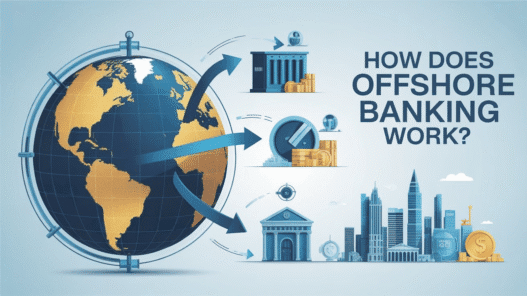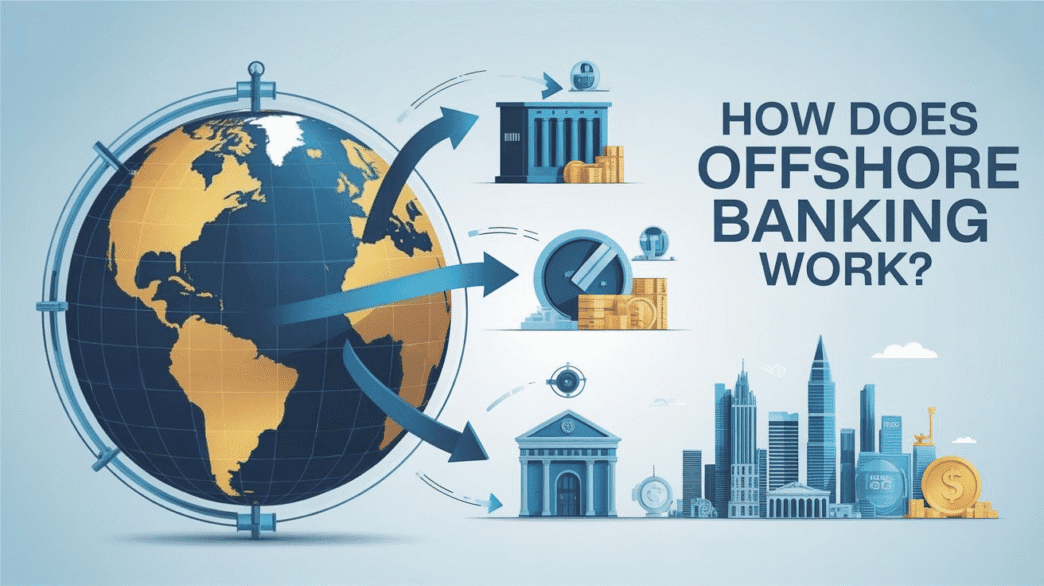Why Offshore Banking Matters

Have you ever wondered how billionaires, multinational corporations, and even world leaders manage to hold on to so much of their money while the average person loses nearly half their paycheck to taxes? The answer often lies in offshore banking.
In this article, we’ll break down how offshore banking works, why it’s both legal and controversial, and how it has shaped the financial strategies of some of the biggest companies in the world. From the Cayman Islands to Switzerland, we’ll explore the hidden world of offshore accounts in a simple, easy-to-understand way without the jargon.
By the end, you’ll know exactly why offshore banking is so attractive to the wealthy, the legal differences between tax avoidance and tax evasion, and whether it’s something you should even consider.
What Exactly Is Offshore Banking?

At its core, offshore banking means placing your money in a financial institution outside of your home country.
These banks are often located in “offshore financial centers” (OFCs), jurisdictions with extremely favorable financial rules. They usually provide three irresistible benefits:
- Low or zero taxes – No income tax, no capital gains tax, no corporate tax.
- Strong privacy laws – Owners’ names are hidden from public and sometimes even internal records.
- Flexible reporting rules – Minimal disclosure requirements compared to countries like the US or UK.
This makes offshore banking especially appealing for high-net-worth individuals, celebrities, and corporations.
Why Do the Rich Use Offshore Banking?
For everyday employees, every dollar earned is taxed before it even reaches the bank account. Salaries are transparent, reported, and monitored. But for the ultra-wealthy, there’s a different playbook.
They don’t technically own their wealth. Instead, their companies, trusts, and foundations own everything on paper. This separation creates a protective shield around their money.
For example:
- A luxury mansion isn’t registered under their name, it’s owned by a shell company.
- A $150 million yacht isn’t personal property, it belongs to a trust.
- Even art collections or intellectual property rights are often tucked away under offshore entities.
By doing this, the rich not only minimize taxes but also protect their assets from lawsuits, government seizures, and creditors.
Offshore Banking vs Traditional Banking

To really understand how offshore banking works, let’s compare it with everyday banking:
Traditional Banking
- Salaried income reported by employer.
- Taxes deducted automatically.
- Transfers above $10,000 flagged.
- Full visibility by government.
Offshore Banking
- Income flows through holding companies and trusts.
- Payments structured as dividends or distributions, often tax-free.
- Ownership hidden through legal layers.
- Transactions largely outside home country’s oversight.
A Tale of Two Millionaires

Let’s simplify with an example.
- James is a salaried CEO in New York making $1 million/year. His employer reports it, taxes are withheld, and James loses nearly half of his income to federal and state taxes.
- Mike, another millionaire, uses an offshore structure. He sets up a trust in the Cayman Islands, a holding company in Luxembourg, and channels profits from his intellectual property through them. Mike only pays taxes when he decides to distribute money to himself often at a far lower rate.
Both are making the same money, but their tax bills look drastically different.
Tax Avoidance vs Tax Evasion
This is where most people get confused.
- Tax Evasion: Illegal. Example: hiding income, getting paid in cash, and not reporting it.
- Tax Avoidance: Legal. Example: using deductions, trusts, or offshore banking structures to reduce taxes.
Offshore banking when done correctly, falls under tax avoidance, not evasion. It’s about using the rules rather than breaking them.
Famous Example: Apple’s Offshore Strategy
One of the most famous offshore banking stories involves Apple Inc.
In the early 2000s, Apple set up subsidiaries in Ireland that technically owned the rights to sell Apple products outside the US. By doing this, profits from iPhones and Macs sold worldwide flowed into Irish entities instead of being taxed in the US.
Here’s the twist: these entities were stateless. They weren’t taxed in Ireland because they weren’t managed from there. They weren’t taxed in the US either because they weren’t incorporated there.
- For over a decade, Apple routed $120 billion through this setup.
- At one point, their effective tax rate was just 0.005%.
- Instead of owing $40 billion under normal tax law, they paid just $600 million.
Eventually, the European Union caught on. In 2024, Apple was ordered to pay $14 billion in back taxes. But for years, this loophole legally saved them tens of billions.
Other Big Names Using Offshore Banking
Apple isn’t alone. Many of the world’s biggest companies rely on offshore structures.
- Amazon – routes profits through Luxembourg.
- Google (Alphabet) – used the “Double Irish, Dutch Sandwich” method.
- Meta (Facebook) – structured advertising profits offshore.
- Nike & Starbucks – shifted royalties and licensing fees through tax havens.
According to studies, over 40% of multinational corporate profits are shifted into offshore jurisdictions each year.
The Panama Papers & Pandora Papers

If offshore banking sounds shady, you’re not alone. Investigations like the Panama Papers (2016) and Pandora Papers (2021) exposed thousands of high-profile figures, from politicians to royalty, using offshore structures.
- 140+ public officials were revealed in the Panama Papers.
- 35 world leaders were linked in the Pandora Papers.
Most of what they did was legal, but it raised ethical questions about fairness, since ordinary taxpayers don’t have access to these loopholes.
How Offshore Banking Structures Work (Step by Step)

Step 1: Set Up a Shell Company
Usually incorporated in the Cayman Islands, British Virgin Islands, or Bermuda. On paper, it’s a real company, but in reality, it exists only in legal documents.
Step 2: Transfer Ownership of Assets
Instead of owning a mansion or yacht directly, the offshore company holds the title.
Step 3: Add a Trust for Extra Protection
The company is then owned by a trust registered in another jurisdiction. The trust owns everything, while the individual is only a beneficiary.
Step 4: Borrow Against Assets Instead of Spending
When billionaires want cash, they don’t repatriate offshore money (which would trigger taxes). Instead, they borrow against their offshore wealth, using it as collateral for loans.
This strategy is known as “Buy, Borrow, Die”:

- Buy assets through offshore companies.
- Borrow against them to get cash tax-free.
- Die, and pass on assets to heirs with minimized tax exposure.
Is Offshore Banking Legal?

Yes, if done correctly. Offshore banking itself isn’t illegal. The issue is intent.
- If it’s used for tax evasion, money laundering, or hiding illegal funds, it’s criminal.
- If it’s used for asset protection, global business operations, and tax optimization, it’s legal.
That’s why governments constantly update laws like FATCA (Foreign Account Tax Compliance Act) to track foreign accounts.
Should You Use Offshore Banking?
For most everyday individuals, offshore banking isn’t practical or necessary. It’s expensive, complex, and requires expert legal and financial guidance.
But for global entrepreneurs, multinational businesses, or high-net-worth individuals, offshore banking can be a legitimate tool for wealth protection and tax efficiency.
The Hidden World of Offshore Banking

So, how does offshore banking work? It works by leveraging favorable foreign laws to protect wealth, minimize taxes, and provide privacy. While it may sound like something out of a crime thriller, the reality is that much of offshore banking is perfectly legal, it’s just not available to the average taxpayer.
The wealthy don’t play by the same financial rules. Instead, they use lawyers, shell companies, trusts, and offshore accounts to ensure they own nothing, but control everything.
And while governments continue to crack down, the system remains alive and well holding more than $10 trillion in assets worldwide.
Disclaimer: This article is for educational purposes only. It does not constitute financial or legal advice. Always consult a licensed professional before making financial decisions
If you enjoyed this guide and want more insights on money, investing, and building wealth, visit Forcefall.com for more in-depth articles and resources.















